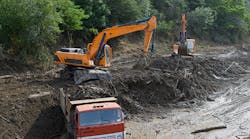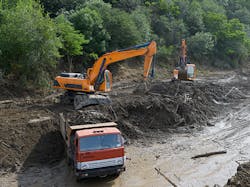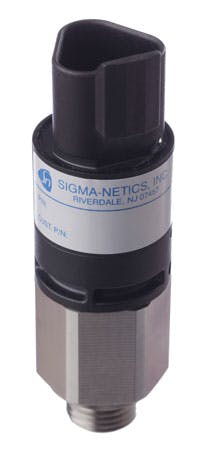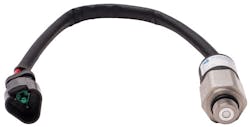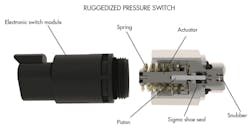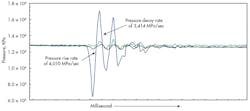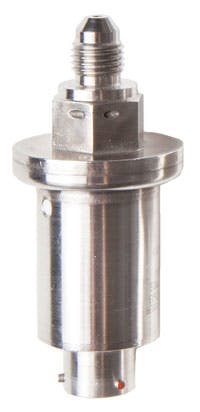How to Make Pressure Switches that Last
Commodity pressure switches fail all the time. And in nonessential fluid control applications, those failures may not amount to much more than the switch’s replacement cost. However, in the fluid control systems used in off-highway equipment, failure really is not an option. These applications require accurate, reliable pressure switching under harsh operating conditions.
Raising the stakes even further, pressure switches help govern truly critical machine subsystems. They are used to monitor fluid in braking, steering, transmission, suspension, and track-tensioning systems in all types of equipment—from civilian earth movers, mobile cranes, and mining machines to off-road military vehicles. On these machines, operator safety subsystems also rely on accurate, failure-proof pressure switching. Likewise, hydraulic auxiliary systems—such as buckets and backhoes—need pressure switching to run. In all of these applications, the wrong pressure switch can cause catastrophic damage or even endanger human life.
So what makes a good pressure switch for these failure-intolerant off-highway applications? First, the switch has to meet the basic application requirements related to pressure, accuracy, size, mounting requirements, and communications. Second, and equally important, the switch has to be rugged.
The notion of “rugged” can be somewhat subjective, and many vendors claim to have ruggedized switches. Rugged is defined as a stable switching response and long lifecycle in the face of seven failure modes—pressure spikes, leaks, temperature extremes, moisture, chemical exposure, vibration, and shock loads. These switches will address all but the most extreme conditions (see “Extreme Ingress Protection” below).
Switches that can withstand all these seven life-ending failure modes have three design principles in common. They tend to have a piston rather than diaphragm design. They have carefully designed pressure-management features and seals. And they use materials and construction methods that mitigate chemical and moisture exposures as well as thermal expansion mismatches. Here is a closer look at these design principles.
Choose Piston-Actuated Switches
Modern pressure switches for off-highway applications, in general, fall into one of two broad categories.
Electromechanical switches include designs in which an internal piston, diaphragm, or both move in response to external pressure changes. This movement trips a snap-acting switching element at a pre-set pressure level, opening or closing an electrical circuit. When we refer to piston-actuation, we mean that a relatively large-diameter sealed piston and actuator operate the switching element directly—without the need for a diaphragm.
Solid-state switches rely on some type of strain gauge to sense the pressure changes and electronic circuitry to initiate the switching response.
All these types of pressure switches have advantages—as long as you use them in the right applications. For example, a simple diaphragm switch may offer a theoretical lifecycle or unit-cost advantage over a piston-actuated design, but the diaphragm switch may not be able to withstand the pressure spikes and environmental conditions found in a heavy equipment application. Likewise, a solid-state switch may initially seem to offer better accuracy or lifecycle than a piston switch, but these data sheet advantages can disappear in an application that experiences extreme pressure spikes or electromagnetic interference (EMI). Solid state switches also require a more complex electrical infrastructure than their mechanical counterparts, which can drive cost.
When it comes to operating in extreme environments, the piston-actuated designs have a number of compelling advantages over other types of pressure switches—even those with comparable or even better data sheet specifications. Well-designed piston switches offer accuracies as well as ± 1 to 2 percent with a narrow dead-band, and they can last for up to 1 million cycles. What makes the piston-actuated pressure switch unique, however, is that it does not lose its accuracy or fail early when exposed to harsh operating conditions.
Just how harsh? Rugged pressure switches need to survive thermal cycling from -65ºF to 250ºF. They have to tolerate shock and vibration loads corresponding to peak accelerations as high as 50 G. They require ingress protection up to IP 67, which keeps out moisture and particulate. They have to tolerate a broad range of fuels and corrosive chemicals. And most challenging of all, they have to survive pressure spikes as aggressive as 1 million psi/second.
Manage Pressure Spikes
Another key differentiator between pressure-switch designs relates to how they measure overpressure conditions. Many ruggedized switches can withstand high pressures by design. Modern designed pressure switches, for example, have proof pressures as high as 12,000 psig and maximum operating pressures up to 7,500 psig. But it is not the steady state pressure that causes a well-designed and properly-specified switch to fail. It is the rise rate of pressure spikes.
Pressure spikes have many causes, ranging from pump ripple to fast valve actuation to control mishaps. And these spikes can reach a surprisingly high rate. We have seen heavy equipment applications that have experienced spikes as high as 1 million psi/second. Pressure spikes this high place enormous stresses on every switch component and represent the most catastrophic failure mode for heavy-duty pressure switches.
Protecting switches from pressure spikes partially comes down to designing robust switch housings, seals, pistons, and actuators. Beefing up the switch components, however, will only get you so far given the magnitude of forces from a 1 million psi/second pressure spike.
At these pressure rates, a ruggedized switch also needs to incorporate design features that keep damaging spikes from ever reaching the pressure switch’s internal electrical switching element. One design approach is to use mechanical features or devices that reduce the size of the orifice into the switch’s pressure chamber, choking off the flow into the switch.
These fluid flow restrictors, called snubbers, can protect against pressure spikes, but they create a design challenge: For high-pressure systems, the ratio of piston area to the orifice through the snubber has to be very high or else the snubber will not provide the desired protection against pressure spikes. In small-diameter pistons, however, this ratio will result in orifice sizes too small to manufacture, much less allow unimpeded fluid flow into the switch and can easily clog as a result of the particulate contamination in the media. An example would be the use of a snubber design whose internal design features restrict fluid flow while preserving a relatively large, clog-resistant orifice. This design provides fluid flow equivalent to a smaller orifice that meets the very high piston-to-orifice ratio.
Further improvements could be made by using an elastomeric switch actuator between the top of the piston and the switch. The elastomer functions as a mallet to soften any pressure-driven blows to the electrical switching element.
Early switch designs used a metal actuator, but we found that the mallet approach can significantly extend switch life in applications with low set point pressures and high line pressures. In these cases, the mallet complements the snubber—by further mitigating the effect of the piston as it impacts the electrical switching element at a high velocity. The mallet softens these blows, protecting the switching element from early stress-fatigue failures.
Pay Attention to Piston Size
Creating a switch that delivers both accuracy and reliability under harsh conditions starts with the proper design of the piston itself, particularly its size.
With piston-based pressure switches, the cross-sectional area of the piston helps determine both accuracy and repeatability. In general, you want a large piston size relative to the overall size of the switch and strength of the various switch materials. Pistons with a large cross-sectional area are inherently more sensitive to small changes in applied pressure.
Larger pistons also help improve the switch’s hysteresis. Also known as the Delta-P value, hysteresis is the percent difference between the switch’s actuation pressure and the pressure at which it returns to its original state. Because the force developed from an applied pressure rises exponentially with piston surface area while friction forces from the seals exhibit only a linear increase, large pistons lessen the friction component of hysteresis. Put differently, contribution of friction forces to the system decreases in relative terms as piston size grows. In a related benefit, reducing friction from the switch’s dynamic surfaces also improves overall repeatability and the longevity. Keep in mind that piston size is only one part of the hysteresis equation. Many other factors come into play, too, including the design and materials of all mechanical components as well as the mechanical characteristics of the electrical switching element.
Designing a switch with a large piston may sound cut and dry, but it does present some design challenges. Size constraints within the switch package place some obvious limits on piston size, but the more challenging issue involves striking a balance between the size of the piston and a calibrated spring that helps control the piston’s response to applied pressure. The spring needs to be compact, given the size of the piston and the overall switch package. Yet the spring also has response and energy-storage requirements that either increase its size or result in very high design stresses.
Striking a good balance between the size of the piston and the spring is one of the overlooked design differentiators that sets apart a good ruggedized pressure switch from a bad one.
Stop the Leaks
Leaks from the switch’s pressure chamber into its electrical cavity are another common failure mode that can be eliminated through careful design. In piston-based switches, leaks usually develop around the dynamic piston seals. And that is no surprise since many switches use elastomer o-rings to create a seal around the moving piston.
At high pressures and cycle counts, however, the issue with o-rings is not so much whether they will leak, but when they will leak. Excessively high pressures will deform elastomer o-rings to the point that they allow fluid to pass by. This problem tends to worsen over time as the elastomer o-ring wears. Furthermore, nibbling of the o-ring may begin to occur with each pressure spike, which can ultimately result in a seal breach. The problems with simple o-rings forced designers to take a different approach toward sealing by using a rigid fluoropolymer seal in conjunction with an o-ring. With its low coefficient of friction and rigidity, the fluoropolymer seal avoids the deformation and wear problems associated with traditional elastomeric o-ring seals even at very high pressures of 30,000 psig.
Use the Right Materials
The last element to consider in a ruggedized pressure switch relates to its construction materials. Failures related to corrosion and moisture tend to have obvious material solutions: The exteriors of most ruggedized pressure switches are constructed from 18-8 stainless steel. The exterior polymer components are made from high-performance engineering plastics, such as glass-filled polyphenylene sulfide (PPS). All the internal components—including springs, piston, and seals—will likewise be made from corrosion-resistant materials.
What is less obvious about the materials in a ruggedized pressure switch is that they need to work together as a system. Switch failures related to temperature extremes all too often occur because pressure-switch designers have not accounted for coefficient of thermal expansion (CTE) mismatches between different materials in the switch. A visual inspection of the switch will not tell you whether the switch manufacturer has managed CTE differences with enough care. But you can and should inspect the performance of the switch across its entire operating temperature range. A switch with well-chosen materials will have a relatively flat response across its temperature range. Switches with poorly chosen materials will often have reduced accuracy or widening Delta-P values at very low or high temperatures—as thermal expansion or contraction change the movement of switch components relative to one another.
Pressure switches come in so many different forms that it is difficult to decide what type will work best in your application. But if your application involves harsh operating conditions and an intolerance of failure, the choice between switches becomes much clearer. Piston-based designs with provisions to manage high pressure spikes, leaks, severe vibration and shock, high humidity, and thermal issues will offer the best balance of accuracy and reliability in the toughest environments.
Extreme Ingress Protection
Most ruggedized pressure switches have an ingress protection level of IP 67. And that level of protection is more than adequate for the vast majority of industrial, aerospace, and heavy equipment applications. Sometimes, though, an application will require more protection against moisture or contamination.
We often have to custom-design these switches since most off-the-shelf models do not reach IP 69 or above. For example, custom aerospace switches are available that have been hermetically sealed to 1×10-8 Torr cc/sec He.
Or to take another example, a custom “dry” pressure switch for a large piece of earth moving equipment. The switch lives on the equipment’s undercarriage, so it is exposed to moisture and constant thermal cycling.
To simulate this demanding end-use environment, the switch undergoes a number of aggressive tests. A “power wash test,” for example, subjects a switch heated to 120ºC to repeated blasts of water at 1,000 psi. A “heated dunk test” repeatedly heats the switch to 120ºC and dunks a meter deep in room temperature water. Under these conditions, a heated switch will tend to draw in the cooler water like a straw.
Surviving these tests and the end-use conditions required a custom design that goes beyond what most ruggedized switches can do. To eliminate all the leak paths that would open up as the switch thermally cycled we had to implement a number of proprietary steps related to managing the thermal expansion (CTE) of the switch, its housing, and sealing materials.
Severe Pressure Spikes
Pressure can quickly get out of hand in many hydraulic systems. We have seen measured pressure spikes as high as 1 million psi/second in some heavy equipment applications.
If that sounds like an unrealistic number, consider that a 5,000 psi rise in pressure over one millisecond translates to a 1 million psi/sec pressure spike. In heavy equipment applications, spikes such as these can occur if, say, an articulated loader hits the ground hard and fast.
These spikes are the leading killer of switches in our experience. But you can design a switch to tolerate extreme pressure spikes. For better switch designs, the pressure snubber and cushioned actuator can absorb the hammer blow associated with a pressure spike. We also optimize the structural integrity of all internal and housing components—in part, by picking materials with high tensile properties.
